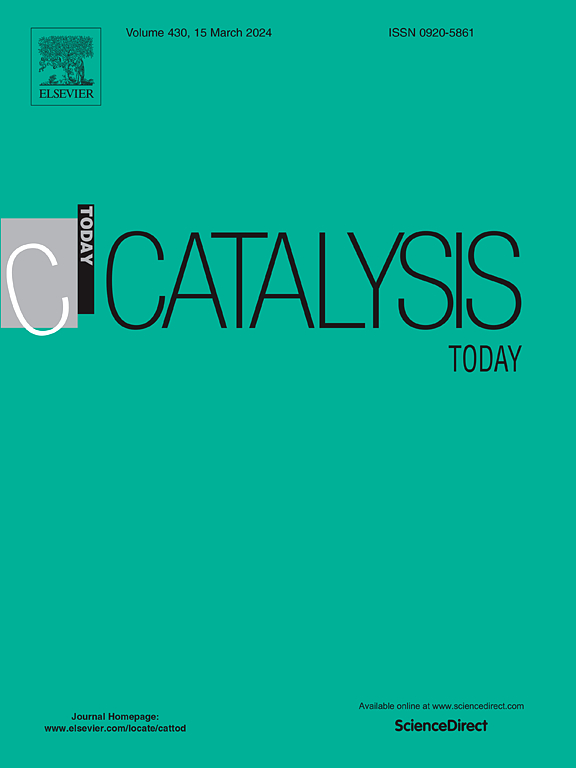以Au和CeO2改性钛基Y型分子筛纳米复合材料在可见光下具有光催化活性
IF 5.2
2区 化学
Q1 CHEMISTRY, APPLIED
引用次数: 0
摘要
得到了两个系列的光催化剂(TYAu、TYCeAu)。钛采用Y沸石直接合成法吸附,铈和金采用双起始湿浸渍法固定化。实验重量百分比(XRF分析)为钛(0.7 %,1.9 %,3.5 %),Ce(1 %)和Au(0.3 %,0.1%)。除Ti含量为3.5% %的样品外,其余样品均保持了Y型沸石的典型晶体结构,XRD显示其图案强度降低。扫描电镜和透射电镜分析表明,钛含量高时,形貌发生了变化。CO₂-TPD证实碱度随着Ti的增加而降低,这与沸石贡献的减少相一致。XPS分析表明,根据Ti含量的不同,表面存在不同的Au0/Au +和Ce³+/Ce4+比例。在含铈样品中,骨架内和骨架外的TiO2以非晶相或锐钛矿相的形式被拉曼证实。对于Ti含量高的材料,主要影响来自Ce和Ti,金的影响更大。紫外可见光谱证实了金纳米粒子的表面等离子体共振效应和Ce固定后带隙能量的下降。在可见光(525 nm)下,通过水裂解制氢和水还原CO2,评价了合成材料的光催化性能。较高的Ti含量提高了CO2的转化率,降低了CH4的选择性,有利于CH3OH和CH2O的生成。钛浓度低的样品产氢量大,而富钛样品中铈的存在有利于反应的进行。本文章由计算机程序翻译,如有差异,请以英文原文为准。
Ti-zeolite Y based nanocomposites modified with Au and CeO2 with photocatalytic activity in visible light
Two series of photocatalysts (TYAu, TYCeAu) were obtained. Ti was incorporated by direct synthesis with zeolite Y, while Ce and Au were immobilized by double incipient wetness impregnation method. The experimental weight percents (XRF analysis) were for titanium (0.7 %, 1.9 %, 3.5 %), Ce (1 %), and Au (0.3 %, 0.1 %). The typical crystalline structure of zeolite Y was preserved in all samples except those with 3.5 % Ti, where XRD revealed reduced pattern intensity. SEM and TEM analyses showed morphological changes at higher Ti contents. CO₂-TPD confirmed a decrease in basicity with increasing Ti, consistent with the diminished zeolite contribution. XPS analysis indicated the presence of varying Au0/Au⁺ and Ce³+/Ce4+ ratios on the surface, depending on the Ti content. The intra- and extraframework TiO2 as amorphous or anatase phases were Raman confirmed in cerium-containing samples. For materials with high Ti content, the dominant effect was from the Ce and Ti species, accentuated by gold. The surface plasmon resonance effect of Au nanoparticles and decreasing in band gap energy after Ce immobilization was evidenced by UV-Vis spectroscopy. The photocatalytic properties of the synthesized materials were evaluated in CO2 reduction with water and H2 production via water splitting under visible light (525 nm). Higher Ti content enhanced CO2 conversion and reduced CH4 selectivity, favoring the production of CH3OH and CH2O. A greater amount of hydrogen was produced by the samples with the lowest Ti concentration while the reaction was favored by the presence of cerium in the rich titanium samples.
求助全文
通过发布文献求助,成功后即可免费获取论文全文。
去求助
来源期刊

Catalysis Today
化学-工程:化工
CiteScore
11.50
自引率
3.80%
发文量
573
审稿时长
2.9 months
期刊介绍:
Catalysis Today focuses on the rapid publication of original invited papers devoted to currently important topics in catalysis and related subjects. The journal only publishes special issues (Proposing a Catalysis Today Special Issue), each of which is supervised by Guest Editors who recruit individual papers and oversee the peer review process. Catalysis Today offers researchers in the field of catalysis in-depth overviews of topical issues.
Both fundamental and applied aspects of catalysis are covered. Subjects such as catalysis of immobilized organometallic and biocatalytic systems are welcome. Subjects related to catalysis such as experimental techniques, adsorption, process technology, synthesis, in situ characterization, computational, theoretical modeling, imaging and others are included if there is a clear relationship to catalysis.
 求助内容:
求助内容: 应助结果提醒方式:
应助结果提醒方式:


